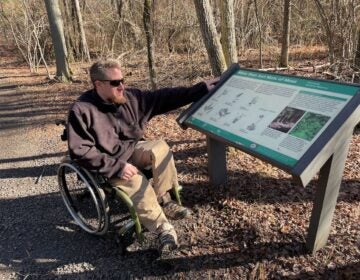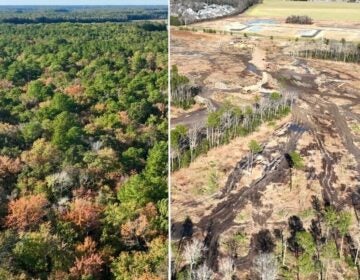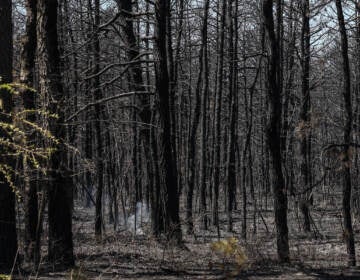Off-road drivers still battling conservationists over access to Pinelands
It's been three years since the DEP scrapped its Motorized Access Plan that would have sharply reduced the number of Pinelands roads and trails that could be legally used.
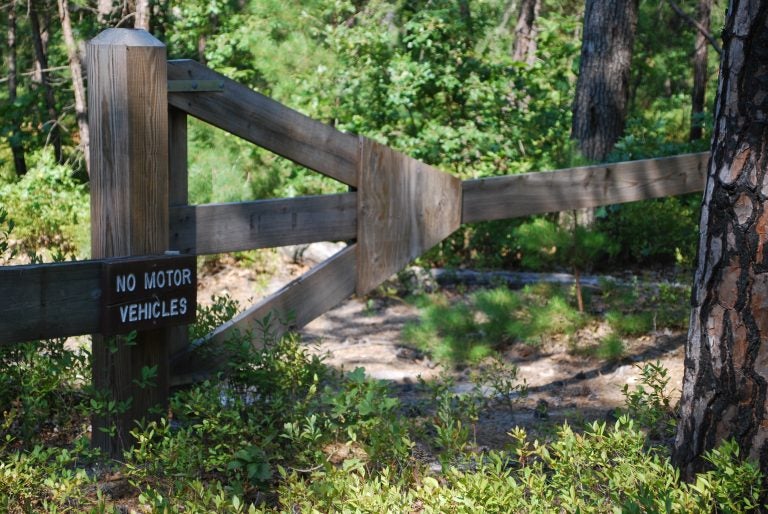
A gate keeps off-road drivers away from the Jemima Mount site in Wharton State Forest. (Jon Hurdle/NJ Spotlight)
This article originally appeared on NJ Spotlight.
—
At the top of Jemima Mount in Wharton State Forest, it’s hard to believe that the thousands of acres of surrounding pine woods remain a battleground between off-road drivers, and the hikers, birders and horse riders who prefer to enjoy the land in non-motorized ways.
The seemingly endless woods of New Jersey’s Pinelands stretch away in all directions, harboring birds, deer, snakes, frogs and other wildlife, but apparently no people or their vehicles.
That’s because Jemima Mount — just a wooded hump about 50 feet above the forest floor and six miles down sandy tracks from the nearest paved road — was declared off limits three years ago to dirt bikes, all-terrain vehicles, and pickup trucks after years of being a favorite target for off-road scrambling that left it deeply rutted, badly eroded, and littered with trash.
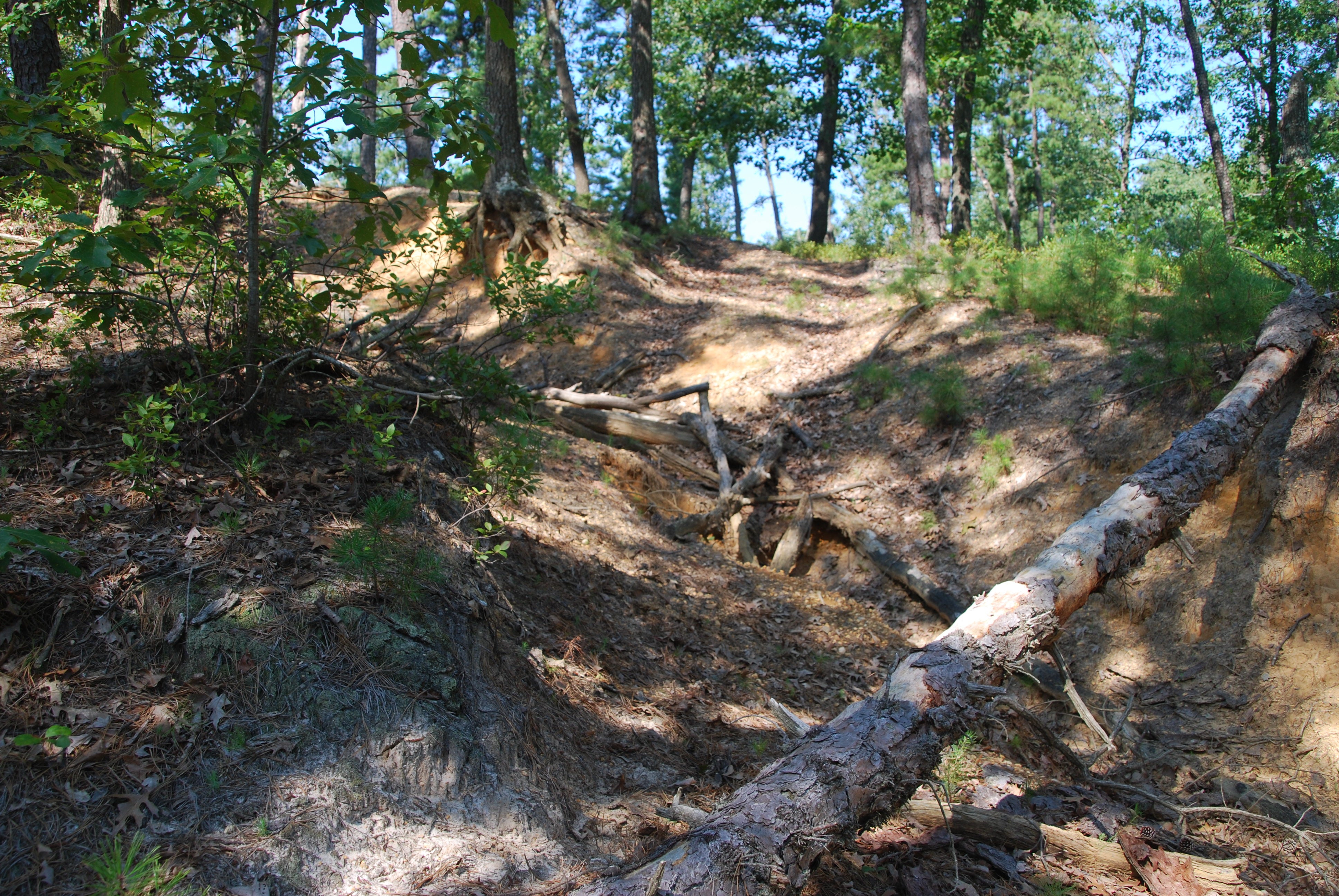
Now, several car-sized ruts on one side are filled with brush and tree trunks to deter any recalcitrant drivers; the hollows that were dug by spinning tires are gradually refilling with soil and vegetation, and six-inch pine seedlings have popped up in places where they would have been crushed beneath speeding vehicles a few years ago. On one side of the mount, regrown vegetation has almost blocked a trail.
Crucially, the drivers have been kept away by stout wooden gates that block access to the site on three sides, and which have proved effective deterrents to off-road vehicles (ORVs) since being built in 2016 by volunteers from Open Trails New Jersey, an outdoors group that otherwise advocates for Pinelands backroads to remain open.
“It’s probably safe to say that not a single tire track has gone up there since we’ve been here,” said John Druding, president of the group.
Deep gullies in sandy banks
It’s a different story at Hidden Lakes in Ocean County’s Greenwood Forest Wildlife Management Area, a 32,000-acre state-owned tract where ORVs still have unfettered access, carving deep gullies into the sandy banks, stripping the lake’s surroundings of its vegetation, and whose riders leave behind piles of beer cans.
Three years after the Department of Environmental Protection scrapped its Motorized Access Plan (M.A.P.) that would have sharply reduced the number of Pinelands roads and trails that could be legally used by ORVs — promising more enforcement instead — places like Greenwood continue to be heavily visited, leaving them eroded, pock-marked with muddy hollows, and partially denuded of ground cover.
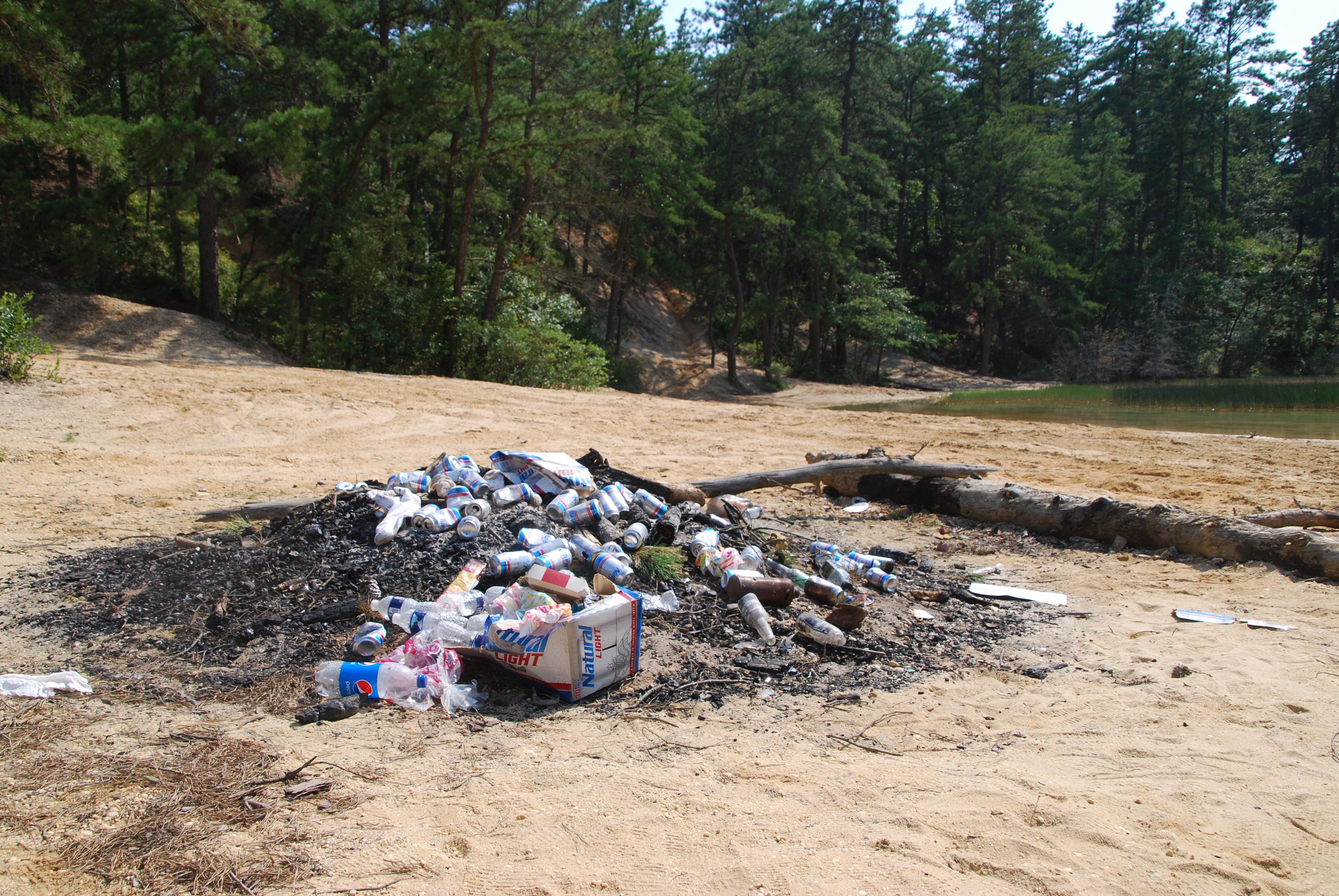
The damage to such places has for years been highlighted by environmental advocates like the Pinelands Preservation Alliance (PPA) and the New Jersey Conservation Foundation which argue that publicly and privately owned sections of the 1.1 million-acre Pinelands continue to be ravaged by lawless drivers who care nothing for the environment or other users of the Pinelands.
Even if the worst offenders are a small minority of all off-road drivers in the Pinelands, their actions have a disproportionately large impact on the environment, advocates say.
“They think it’s their God-given right to do whatever they want on whoever’s land that they want,” said Jason Howell, Stewardship Coordinator for the PPA, during a recent tour of some damaged sites. “They don’t care that we want to preserve pine snakes and tree frogs; it’s not their perspective. So they must be met on their own terms, which is with the force of the law. Without those disincentives, it’s just going to keep happening.”
While the ORVs have been recently shut out of a handful of sites like Jemima Mount, they are still effectively free to roam over most of the enormous Pinelands. That, Howell says, is the fault of the DEP which caved in to a storm of protest against the M.A.P. in 2016, and which since then has largely failed to enforce existing rules on motorized access to the Pinelands.
Blaming the state government
“It’s the fault of the state government because they have refused to clarify where people are allowed to drive, with any kind of vehicle, and where you are allowed to hike or bike, or ride a horse,” he said.
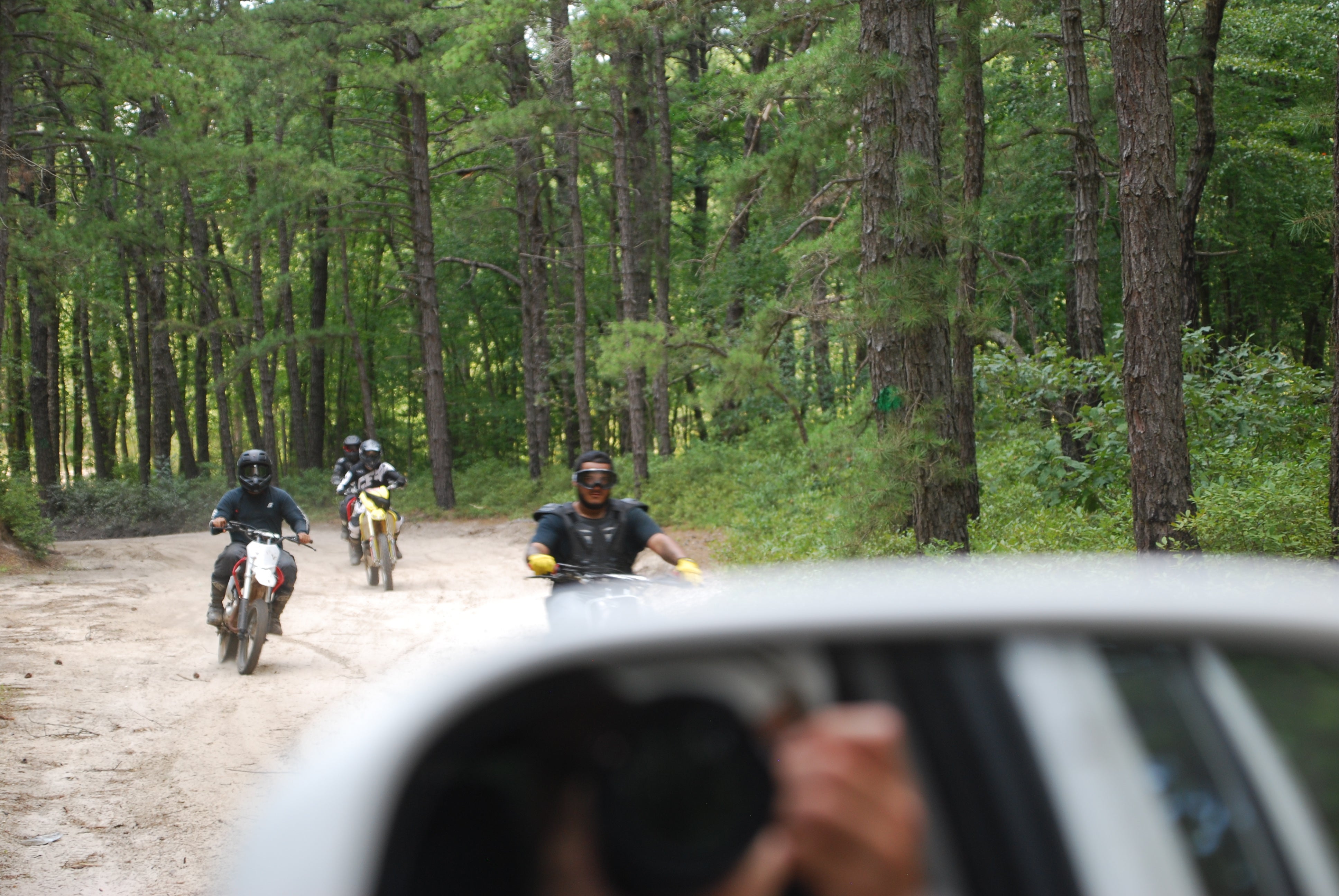
Still, most drivers know when they are driving on unpermitted roads, Howell said, pointing to a group of dirt bikers who sped away from his pickup truck into the woods at Colliers Mills Wildlife Management Area, a 12,000-acre state-owned tract in Ocean County, perhaps thinking it was an official vehicle.
But even if they had an effective rule book for Pinelands access, the DEP’s few park police and conservation officers are overwhelmed by the scale of the Pinelands, its vast network of sand roads and trails, and by the fact that ATVs, dirt bikes and even pickup trucks are often able to drive into areas that are inaccessible to rangers’ vehicles.
For the few illegal drivers who are caught and ticketed, the standard fine of $74 is hardly a significant deterrent to them doing it again, Howell said, urging much higher fines or vehicle impoundment.
Damaging ponds and dunes
Conservationists are not advocating the complete exclusion of ORVs from the Pinelands, but insist that the drivers should keep to established roads, and face stiff penalties for straying into the woods or driving through ponds and wetlands, a favorite activity of off-roaders called “mudding.”
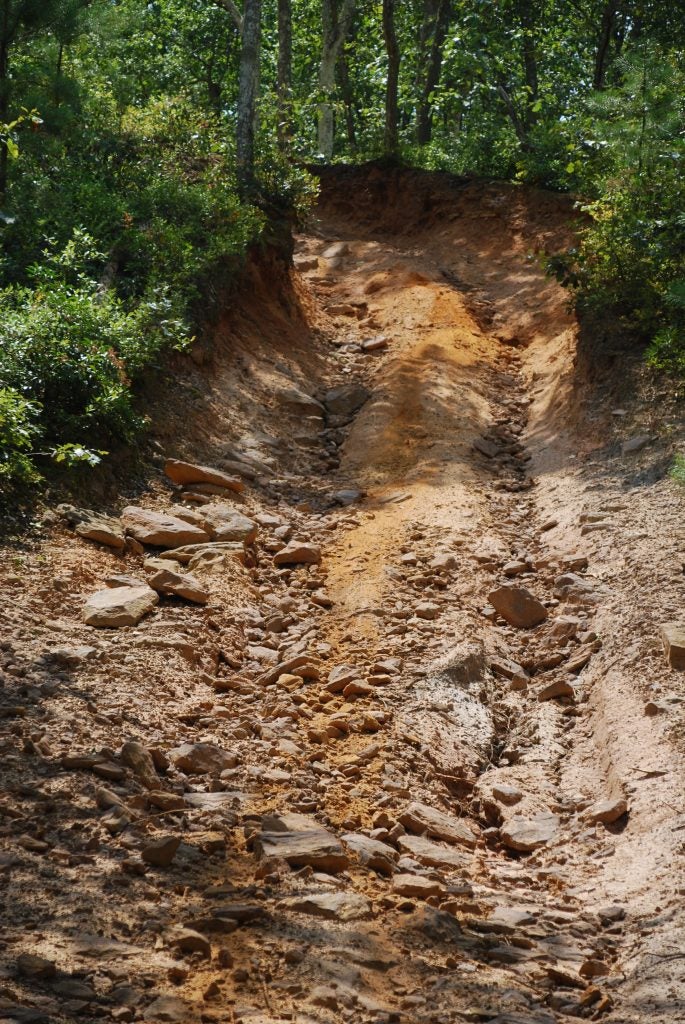
“Driving along an old sand road, I don’t think anyone has a problem with that,” Howell said. “It’s when a vehicle is turned onto a pond that’s home to an endangered species or a dune where you might have a plant that only grows in a few places in the entire state or an endangered snake that needs that same dune to lay its eggs on. It’s when that vehicle is turned against the land, that’s when it becomes a problem.”
One recent win for conservation was the purchase by Ocean County Natural Lands Trust of 8,000 acres in Ocean County’s Forked River Mountains, which has been a big magnet for ORVs and which is expected to be transformed under its new ownership.
Still, if ORV drivers are banned from one site, they will just go to another, underlining the need for a comprehensive solution such as the M.A.P. plan, Howell said.
The PPA is renewing its efforts to persuade the DEP to find a systematic solution to ORVs in the Pinelands, hoping that the Murphy administration, with its pro-environment stance, will be more sympathetic than its predecessor.
“With the change in administration, the DEP should now feel confident enough to move forward on creating a solution,” Howell said.
To bolster its case, the PPA has recently published a slide deck that includes pictures of ORVs in the Pinelands, and wild creatures that PAA says have been killed by the vehicles. DEP did not respond to several requests for comment for this story.
Druding of Open Trails New Jersey argued that a better approach to stopping ORV damage to the Pinelands is to block access to “hotspots” like Jemima Mount while keeping trails open for people like himself who use the Pinelands roads for access to activities like hiking, biking, kayaking or hunting. He said the “vast majority” of his members use the trails for access to non-motorized activities and not because they simply want to drive through the woods.
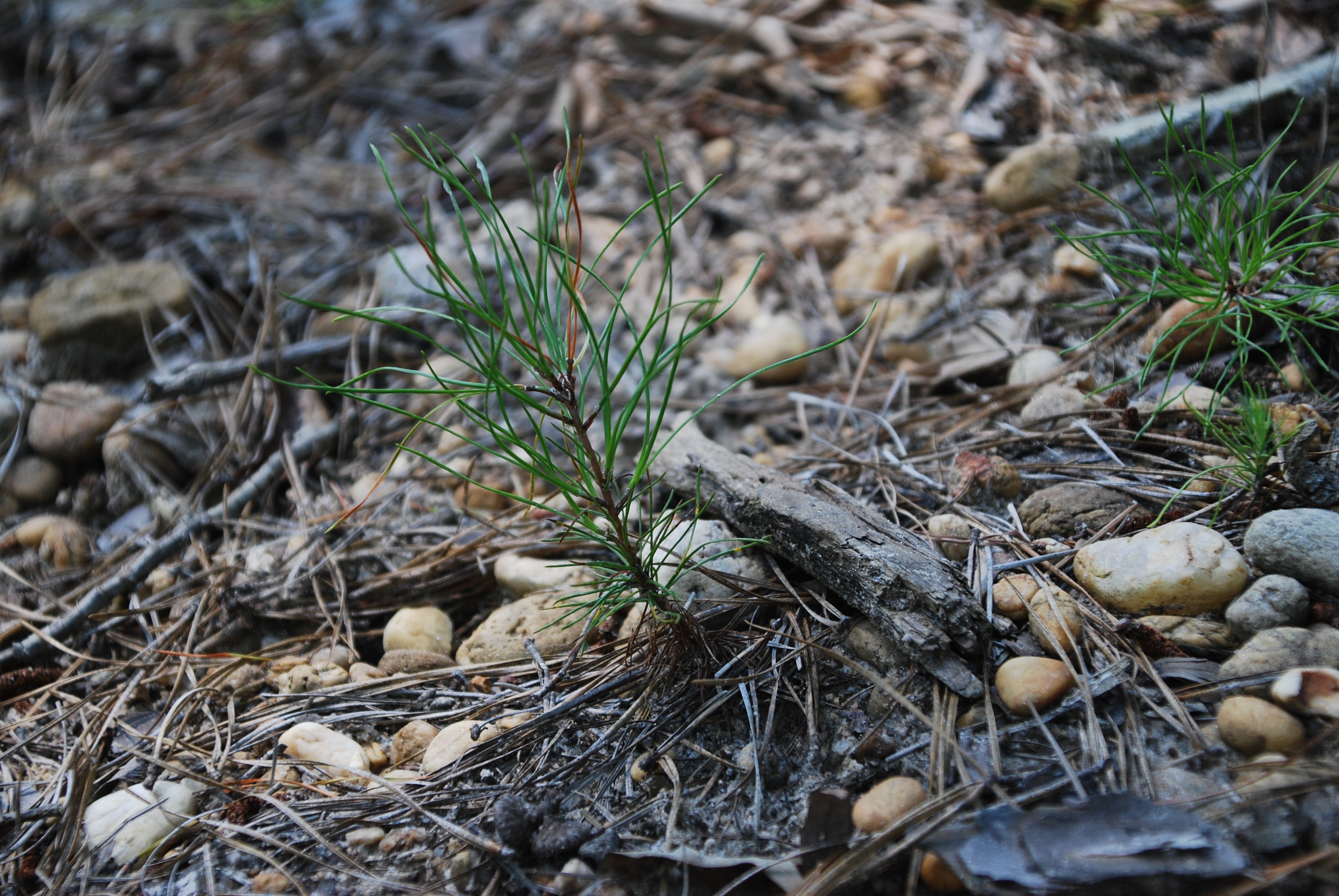
On one side of Jemima Mount, there’s a sign saying “No Motor Vehicles” and wooden barriers on both sides of the gate. There’s no fence either side of the gate, offering dirt bikes or ATVs the opportunity to simply drive around the gate and on to the mount if they wanted to. But the undisturbed land beyond the gate shows that drivers have indeed stayed away in the last three years. That, Druding said, may be because they know that the gate was installed — with the DEP’s cooperation — by people who are on their side.
“We made as big a deal out of this as the state did,” Druding said. “The message was: ‘We’re protecting this area; it’s off limits. If you want to have those roads that got us here, don’t abuse this.’”
The ‘bad actors’
Druding fears that continuing abuse of some sites by the drivers he calls “bad actors” will prompt state authorities to try again to restrict access, and will end up penalizing the vast majority of forest users who don’t cause the damage.
Off-roaders’ hopes that trails will stay open rose in 2017 when the Pinelands Commission published a map showing all existing Pinelands roads, and recommended to the DEP that they were all suitable for ORV use. The commission’s plan, if implemented by DEP, would represent a big improvement over the M.A.P., said Druding of Open Trails New Jersey.
The commission said it is working with DEP on the issue of illegal ORV use in Wharton State Forest and other areas of the Pinelands, and has built wooden barriers to keep the vehicles away from some ponds.
Fences torn down
It said it “has taken numerous steps to combat the damages wrought by off-road vehicle use in Wharton State Forest and other areas of the Pinelands.”
While ORV drivers have so far respected the barriers at Jemima Mount, they have destroyed similar efforts by conservationists to protect other sensitive sites, said Howell of the PPA. Many fences or barriers have been torn down; signs saying an area is closed to motor vehicles are ripped from trees, and newly planted trees have been uprooted, he said.
“Any barrier that you put in, anything, will be pulled out, whether it’s a welded steel gate, whether it’s piles of stumps and logs, thick braided cable,” he said. “You take your mud truck and a rope or cable, and you attach it to the barrier and you drive as fast as you can until it gets torn out of the ground.” By contrast, Jemima Mount has been spared because, according to Druding, ORV drivers know its closure was initiated by Open Trails, and not by conservationists. Conservationists accept that they often need to reinstall such barriers but wish that law-enforcement would crack down on the vandalism so that they don’t have to duplicate their work, he said.
Bad blood between the two sides can even lead to violence, Howell said. He said his pickup was rammed from behind by a “mud truck” near Whitesbog Village in Burlington County in May after Howell had been working at an off-roading site there.
“He saw the ladder in the back of my truck, and he probably figured that I was one of the people who was making it into a preserve, and changing it from just a lawless, mudding, dumping ground,” Howell said. “He was revving up behind me in the mud puddles as I was leaving, getting way too close then pulling off. Then as I was turning to go to Whitesbog village, he sped up and rammed the back of the truck.”
Fearing the consequences
Howell said the truck had no license plates that he could call in to the police, and that he wasn’t going to get out of his pickup to confront the driver because he feared the consequences.
“That guy could have done anything he wanted to at that moment and there would have been absolutely no way for me to have any recourse,” he said.
Meanwhile, privately owned tracts also struggle to keep ORVs out. On the site of a former gravel quarry that’s part of the Franklin Parker preserve in Burlington County, the New Jersey Conservation Foundation is hoping to reforest an area of bare sand several hundred yards across, but it knows there’s no point in doing so until it can keep the ORVs out.
To that end, it has fixed yellow “Posted” signs on trees around the property — high enough to discourage drivers from tearing them down — and has arranged with a local DEP conservation officer to stop in frequently and ticket any ORV drivers she finds there.
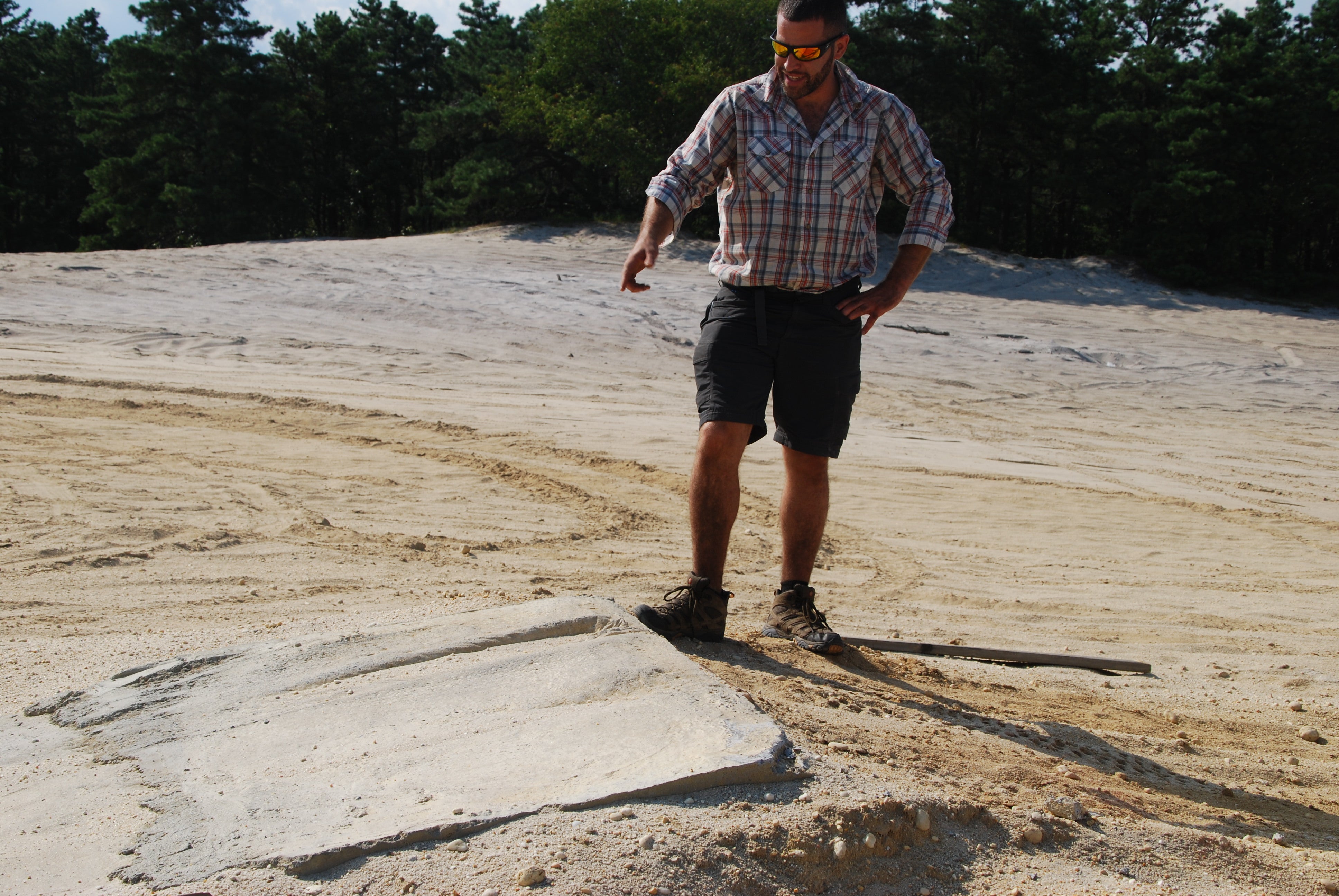
As a result, ORV use at the site appears to have dropped, according to Emile DeVito, manager of science and stewardship for the foundation. But the task clearly isn’t complete, as shown by a new concrete ramp for dirt bikes to use as a jump at the site.
Ideally, the site would be fenced off with cables but that’s a costly exercise, and would only make sense if backed up by more enforcement by park police, DeVito said. Besides, there’s a risk the cable would simply be stolen and sold for scrap metal, he said.
Threatened species
In nearby Brendan T. Byrne State Forest, DeVito is trying to convince DEP that it shouldn’t allow off-road motorcycle events by “enduro” riders because the forest is home to the pine snake, a threatened species, and a good indicator of the ecological health of the Pinelands as a whole.
One female snake that nested near a bike trail was crushed by a motorcycle in March this year as the snake lay in the trail to warm itself, DeVito said. The dead snake, which had been radio-tagged, was found by researchers who tracked its movements outside the nest and then discovered its fate, he said.
The snakes, which are also threatened by poaching for the pet market, are likely to breed and hibernate near the bike paths because they colonize the stumps that are created by the forest fire service when they clear fire breaks, DeVito said. The breaks are often adopted by enduro riders.
The snakes’ presence, though not as obvious as other wildlife like birds, indicates that the whole forest is critical habitat where dirt biking should not be allowed, but that hasn’t yet been accepted by the DEP, DeVito said.
“None of the state forest should have single-track races in it because it’s all critical habitat so they should stay on the roads, and if they don’t want to stay on the roads, they should go race in some other state,” he said.
For Jeep Jamboree, a national organization that organizes annual off-road rallies in the Pinelands, there’s no tolerance of individual drivers who stray off permitted routes, said the president, Pearse Umlauf.
No tolerance for misbehavior
“I will stand up against any of my peers who are behaving poorly out there,” he said. “They should be removed from trails immediately and permanently but it doesn’t mean you close it down to the entire community.”
Umlauf said his rallies of around 50 drivers are fully permitted by Wharton State Forest which this year postponed the event from March to October because of high water levels in the forest.
“Groups like ours who abide by the rules of a permit get punished by not using the trails because of a few knuckle-heads,” he said. “Those are the people who cost us the opportunity to recreate.”
In the vast Wharton State Forest — 122,000 acres straddling Atlantic, Burlington and Camden counties — the volunteers of Open Trails New Jersey hope their success in blocking access to Jemima Mount will persuade the DEP not to revive the M.A.P. or anything like it.
“There was no explicit quid pro quo but our hope was that if we could demonstrate that these projects work, the DEP would not move forward with closing off a bunch of roads,” Druding said.
He argued that, without a big and unexpected increase in resources, the DEP has little chance of effectively enforcing access laws in the vast Pinelands, and so the only real solution is to stop people using badly damaged sites.
“And if they do implement a M.A.P. and close a bunch of roads, who the heck is going to enforce it?” he said.
WHYY is your source for fact-based, in-depth journalism and information. As a nonprofit organization, we rely on financial support from readers like you. Please give today.


